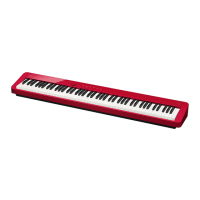EN-50
● Nothing happens when I touch a touch button.
● No sound is produced when I press a keyboard key.
● The Digital Piano emits a loud sound and suddenly
turns off.
● The pitch of the Digital Piano is off.
● Nothing happens when I press a pedal.
● Tones and/or effects sound strange. Note intensity
does not change even though I alter key pressure.
Turning power off and then back on again does not
eliminate the problem.
● I cannot transfer data after connecting the Digital Piano
to a computer.
● A tone’s quality and volume sounds slightly different
depending where it is played on the keyboard.
Troubleshooting
Cause:
a. Wearing glove or touching with a fingernail or stylus.
b. Incorrect touch button sensitivity setting.
Action:
a. When operating a touch button, touch it firmly with a
bare finger.
b. Perform the steps below to increase touch button
sensitivity.
(1) Turn off the Digital Piano.
(2) While holding down the C8 keyboard key (the one
on the far right), press the 1P (Power) button.
• Keep the C8 keyboard depressed until the touch
buttons start to light in sequence from left to right
(from 3 FUNCTION to 8 GRAND PIANO).
You do not need to keep the 1P (Power) button
depressed.
Cause:
a. The 2 volume knob setting is too low.
b. Headphones or an adaptor plug is plugged into one of
the 9 PHONES jacks.
c. MIDI Local control is turned off.
Action:
a. Rotate the 2 volume knob.
b. Disconnect whatever is connected to the 9 PHONES
jacks.
c. Turn on the Local control setting (page EN-43).
Action:
Replace the batteries with new ones or switch over to AC
adaptor power (page EN-5).
Cause:
a. The current transpose setting of the keyboard is
something other than the default setting.
b. The Digital Piano’s tuning setting is something other
than “440.0Hz”.
c. Octave shift is enabled.
d. The current scale setting is something other than “Equal
Temperament”.
Action:
a. Return transpose (page EN-14) to its initial default
setting.
b. Change the tuning setting to “440.0Hz” (page EN-15),
and return Upper2 Detune and Lower Detune (page
EN-40) to their default settings.
c. Change the octave shift setting to 0 (page EN-15).
d. Change the scale setting to “Equal Temperament”.
Cause:
The pedal cord is not connected correctly to the
bm DAMPER PEDAL jack or bn PEDAL UNIT jack, or
the plug is not plugged in completely.
Action:
Confirm that the pedal cord is connected correctly, and that
the plug is inserted as far as it will go.
Cause:
Auto Resume is enabled.
Action:
Disable Auto Resume (page EN-45) and turn off power.
Action:
a. Check to make sure that the USB cable is connected to
the Digital Piano and computer, and that the correct
device is selected with your computer’s music software.
b. Turn off the Digital Piano and then exit the music
software on your computer. Next, turn the Digital Piano
back on and then restart the music software on your
computer.
Cause:
This is an unavoidable result of the digital sampling
process,* and does not indicate malfunction.
* Multiple digital samples are taken for the low range,
middle range, and high range of the original musical
instrument. Because of this, there may be very slight
differences in tonal quality and volume between sample
ranges.

